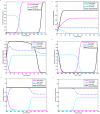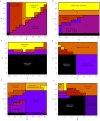Socio-ecological dynamics of Caribbean coral reef ecosystems and conservation opinion propagation
- PMID: 29416056
- PMCID: PMC5803238
- DOI: 10.1038/s41598-018-20341-0
Socio-ecological dynamics of Caribbean coral reef ecosystems and conservation opinion propagation
Erratum in
-
Author Correction: Socio-ecological dynamics of Caribbean coral reef ecosystems and conservation opinion propagation.Sci Rep. 2018 Nov 8;8(1):16758. doi: 10.1038/s41598-018-33573-x. Sci Rep. 2018. PMID: 30409979 Free PMC article.
Abstract
The Caribbean coral reef ecosystem has experienced a long history of deterioration due to various stressors. For instance, over-fishing of parrotfish - an important grazer of macroalgae that can prevent destructive overgrowth of macroalgae - has threatened reef ecosystems in recent decades and stimulated conservation efforts such as the formation of marine protected areas. Here we develop a mathematical model of coupled socio-ecological interactions between reef dynamics and conservation opinion dynamics to better understand how natural and human factors interact individually and in combination to determine coral reef cover. We find that the coupling opinion and reef systems generates complex dynamics that are difficult to anticipate without use of a model. For instance, instead of converging to a stable state of constant coral cover and conservationist opinion, the system can oscillate between low and high live coral cover as human opinion oscillates in a boom-bust cycle between complacency and concern. Out of various possible parameter manipulations, we also find that raising awareness of coral reef endangerment best avoids counter-productive nonlinear feedbacks and always increases and stabilizes live coral reef cover. In conclusion, an improved understanding of coupled opinion-reef dynamics under anthrogenic stressors is possible using coupled socio-ecological models, and such models should be further researched.
Conflict of interest statement
The authors declare no competing interests.
Figures




Similar articles
-
Coral reef systems of the Mexican Caribbean: Status, recent trends and conservation.Mar Pollut Bull. 2019 Mar;140:616-625. doi: 10.1016/j.marpolbul.2018.07.005. Epub 2018 Jul 11. Mar Pollut Bull. 2019. PMID: 30005908
-
Making a model meaningful to coral reef managers in a developing nation: a case study of overfishing and rock anchoring in Indonesia.Conserv Biol. 2010 Oct;24(5):1316-26. doi: 10.1111/j.1523-1739.2010.01487.x. Conserv Biol. 2010. PMID: 20337685
-
Local Overfishing Patterns Have Regional Effects on Health of Coral, and Economic Transitions Can Promote Its Recovery.Bull Math Biol. 2022 Feb 19;84(4):46. doi: 10.1007/s11538-022-01000-y. Bull Math Biol. 2022. PMID: 35182222
-
A geological perspective on the degradation and conservation of western Atlantic coral reefs.Conserv Biol. 2016 Aug;30(4):706-15. doi: 10.1111/cobi.12725. Epub 2016 Apr 29. Conserv Biol. 2016. PMID: 27029403 Review.
-
Coral reefs: threats and conservation in an era of global change.Ann N Y Acad Sci. 2009 Apr;1162:136-86. doi: 10.1111/j.1749-6632.2009.04493.x. Ann N Y Acad Sci. 2009. PMID: 19432648 Review.
Cited by
-
Comparative Analysis of the Soluble Proteome and the Cytolytic Activity of Unbleached and Bleached Millepora complanata ("Fire Coral") from the Mexican Caribbean.Mar Drugs. 2019 Jul 3;17(7):393. doi: 10.3390/md17070393. Mar Drugs. 2019. PMID: 31277227 Free PMC article.
-
Multiple social network influences can generate unexpected environmental outcomes.Sci Rep. 2021 May 7;11(1):9768. doi: 10.1038/s41598-021-89143-1. Sci Rep. 2021. PMID: 33963221 Free PMC article.
References
-
- Molles MC., Jr. Ecology: Concepts and Applications. 4th Edition. New York, NY: The McGraw-Hill Companies; 2008.
-
- Gardner TA, Cote IM, Gill JA, Grant A, Watkinson AR. Hurricanes and caribbean coral reefs: impacts, recovery patterns, and role in long-term decline. Ecology. 2005;86:174–184. doi: 10.1890/04-0141. - DOI
-
- Jackson, J., Donovan, M., Cramer, K. & Lam, V. Status and trends of caribbean coral reefs: 1970–2012. Tech. Rep., Global Coral Reef Monitoring Network (2014).
MeSH terms
LinkOut - more resources
Full Text Sources
Other Literature Sources

